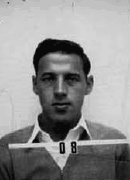Julius Ashkin
| Julius Ashkin | |
|---|---|

Julius Askin's Los Alamos ID badge
|
|
| Born |
August 23, 1920 Brooklyn, New York |
| Died | June 4, 1982 (aged 61) Bronx, New York |
| Citizenship | United States |
| Fields | Physics |
| Institutions |
Metallurgical Laboratory Los Alamos Laboratory University of Rochester Carnegie Mellon University |
| Alma mater | Columbia University |
| Thesis | Two problems in the statistical mechanics of crystals. I. The propagation of order in crystal lattices II. The statistics of two-dimensional lattices with four components. (1943) |
| Doctoral advisor | Willis Lamb |
Julius Ashkin (August 23, 1920 – June 4, 1982) was a leader in experimental and theoretical physics known for furthering the evolution of particle physics from nuclear physics. As a theoretical physicist he made contributions in the fields of statistical mechanics, solid state physics, nuclear physics, and elementary particle physics. As an experimental physicist his main contributions concerned the passage of certain particles (pi-mesons, or pions) through solid matter and their subsequent decay. He was recognized for the quality of his research and teaching.
Julius Ashkin was born in Brooklyn, New York, on August 23, 1920. His parents were Isadore and Anna Ashkin. He had two younger siblings, a brother, Arthur, also a physicist, and a sister, Ruth. One older sibling, Gertrude, died while young. The family home was in Brooklyn, New York, at 983 E 27 Street. Isadore had immigrated to the United States from Odessa, Russia at the age of 19. Anna, five years younger, also came from the Ukraine (in her case Galicia). Within a decade of his landing in New York, Isadore had become a U.S. citizen and was running a dental laboratory at 139 Delancey Street in Manhattan.
Ashkin attended Brooklyn's James Madison High School, graduating in 1936, while still a few weeks shy of his 16th birthday. In his senior year, he received honors and awards. He was awarded a scholarship to attend Columbia University, where he studied four years as an undergraduate from 1936 to 1940, and three as a graduate from 1940 to 1943.
Physicists then working on Columbia's faculty in those years included professors Enrico Fermi, Isidor Isaac Rabi, Hans Bethe (visiting), Edward Teller (visiting), and instructors Arnold Nordsieck, Hugh Paxton, and Willis Lamb. All these men were recognized as among the finest of their generation and four of them — Fermi, Rabi, Bethe, and Lamb — were to be awarded the Nobel Prize.
...
Wikipedia
